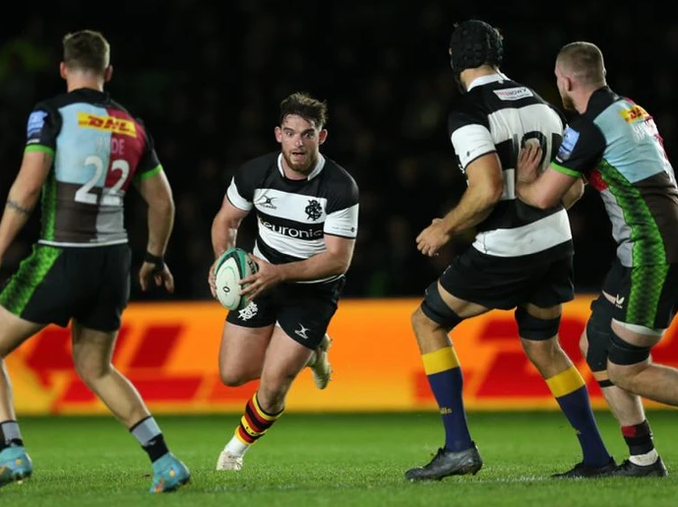Welcome to Part 2 of our Q&A series with Tom Daly, the dynamic centre from Connacht Rugby. In this segment, we delve into the heart of the training routine, focusing on a crucial yet often overlooked aspect: exercise technique. From perfecting form to optimising performance, Tom Daly shares his insights on how mastering exercise technique plays a pivotal role in his journey to becoming a rugby powerhouse. Whether you're an athlete or a fitness enthusiast, there is something in this for you.

Tom Daly in action for Connacht Rugby versus Racing 92 in the París La Défense Arena.
As a professional rugby player, how do you prioritise exercise technique in the gym, and how has it contributed to improvements in your on-field performance?
Proper exercise technique allows you to complete the movement with minimal injury risk. It also allows you to obtain the desired gains and benefits from each exercise. All of our programmes are individualised to your own specific goals. These goals will be set out with input from yourself, strength and conditioning coaches and also the rugby coaches. For me, being a centre, strength and power exercises would be prioritised in the gym. Being able to complete complex movements like Olympic lifts has allowed my power and speed to improve throughout the years. Sprinting technique and mechanics are another focus area for all rugby players. Corrections in technique and gait can lead to marginal gains which will have a big impact on player’s speed.
Can you share specific examples of how focusing on proper exercise technique during strength and conditioning workouts has enhanced your functional strength and power during rugby matches?
We work a lot on plyometric exercises during power sessions in the gym. Exercises such as counter movement jumps, box jumps, hurdle hops and drop jumps are all commonly used in my programmes. Completing these exercises with the correct technique and intent is vital to see the desired increases in speed and explosiveness on the pitch. Our coaches will constantly queue us to complete these ballistic movements with intent (check out this blog on how tech can increase intent and motivation with athletes in the gym). Gains are easily measured through CMJ heights and RSI scores.
How does maintaining good exercise technique help prevent injuries, and what role does injury prevention play in ensuring consistent performance throughout the rugby season?
One of the most important skills in rugby is availability. In a contact sport where injuries are so common, keeping yourself fit and available is so important. Injuries are not only acquired on the pitch, but in the gym too. Correct lifting technique minimises this risk. All rugby players will have their own individual prehab exercise programmes that will be completed outside of squad sessions. These are exercises targeting areas of weakness or imbalances in the body. Often they will focus on areas of the body that have been previously injured or have had recurrent injuries. For me, I’ve had 2 significant knee injuries and I really try to keep on top of my quad and hamstring strength as they are the two major stabilisers for the knee. Throughout a season you will pick up knocks and therefor will spend time working on other areas too.

In what ways does exercise technique in the gym transfer to rugby-specific skills, such as tackling, rucking, and explosive sprinting, resulting in a more well-rounded and capable player?
Rugby is a simple game; you are trying to get from one end of the field to the other while the opposition try to stop you. It is a power and contact based game. All the above skills are power based skills. You want to be as explosive as possible going into tackles, rucks and ball carrying. As a result, most rugby gym sessions will have strength and power exercises. As I said earlier, you will only get the desired results from exercises if you are completing them with correct technique. Being able to complete power exercises on a weekly basis allows us to preform our jobs on the pitch but also allows us to become more robust and durable to back it up week on week.
How do you and your team's strength coaches ensure that exercise technique is consistently emphasised and executed correctly during training sessions to maximise its impact on your performance?
We are lucky in Connacht in that we have 3-4 strength and conditioning coaches on the gym floor during sessions. It is very rare someone will be doing a heavy lift without an S+C coach having eyes on. We do complete numerous complex, heavy lifts in the gym where technique is vital to minimising injury risk such as Olympic lifts, heavy squats and deadlifts. From a young age I have been coached proper techniques for these lifts, but coaches are constantly there to feedback and coach during sessions to ensure proper technique.
As a professional rugby player, how has the focus on exercise technique helped you overcome performance plateaus and push your physical capabilities to new heights on the rugby field?
I suppose as a rugby player, the biggest plateaus you face are injuries. When you are injured, you spend the majority of your time in the gym with your physio. Your gym sessions are the focus of your day whereas when you are fit, the rugby session is your primary session. When you have an extended period out injured it allows you to really focus on getting your body in the best possible condition for your return. Although you are focusing on getting one part of your body back to where it was, you can really go after improving other areas. The strength and conditioning coaches put a big emphasis on making significant gains to ensure you come back a stronger player from the injury.
Stay tuned for Part 3 and be among the first to experience the excitement of our beta trials. You can also go back and read Part 1 with Tom here.




